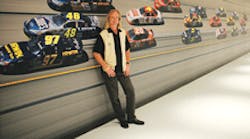Rick Graves got the inspiration for what would come to be called DistaCam when a bored ad director asked him for a completely new idea. Instead of grousing, Graves came up with a modernized version of a technique once used in horse-track finish-line cameras and military aerial surveillance.
He prototyped his concept with a linear filter — basically a gray piece of plastic with a narrow slit — and a Nikon camera. This setup let him capture not a series of frames but a continuous image on a single 66-in. roll of film.
Trying the idea out by taking some photos of race cars, Graves first shot the entire roll of film with the lens covered so that no light hit the film. He then aimed his camera at a car, opened the shutter, and manually rewound the film back through the camera. Test rolls shot this way so impressed the creative director, he commissioned similar linear images for some new-car brochures.
Next came mechanizing the technique and making it repeatable. The first prototype used a windshield-wiper motor attached to a Nikon camera. The next prototype used a Hasselblad camera with a cordless drill moving the film. Eventually, a brushed dc motor replaced the drill. A simple potentiometer with a bicycle speedometer controlled the motor and set its rpm. One problem: Subtle changes in motor speed left vertical lines on the film. A 1-lb flywheel attached to the motor shaft all but eliminated this vertical banding.
Nevertheless, the setup was a bit kludgy and heavy. To make a shot, Graves would first start the motor and turn the potentiometer to get the desired speed. He’d then switch off the motor while he loaded the film, then switched it back on to make the shot. The whole rig weighed about 20 lb.
Things took a turn for the better when Graves hooked up with Oriental Motor. Application engineers there suggested replacing the DCBR motor with a stepper. This halved the weight and resulted in a device about half the size of the original. Speed selection became more precise as well. The stepper controller lets Graves program up to four different speeds using a thumbwheel. This is important because he typically brackets motor rpm’s by ±10% around the optimal speed to allow for variations in speed and distance of his subjects.
Graves’ technique depends heavily on math. He must know the speed of the subject and the distance from the camera to make a clear image. He typically uses a radar gun to acquire the speed and a measuring tape or laser range finder to determine the distance. These two numbers are inputs on a spreadsheet that gives the rpm needed to move the film at the proper speed. The same spreadsheet outputs an effective shutter speed that determines the aperture for correct exposure using a handheld light meter.
One of the unusual effects with this camera technique is the distortion of subjects that are moving faster or slower and are closer or farther than the camera is set for. A group of subjects moving through the frame single file at the correct distance and speed appear proportionally correct. However, they get distorted if they vary in speed or distance. Subjects that move too slowly or are farther away than the camera setting get stretched. Conversely, subjects traveling too quickly or too closely will appear compressed. With certain subjects, this adds an artistic touch. With others, it can be distracting, says Graves.
The first test of the new system came at the 2004 Tour de France. Graves paid special attention to the cyclists’ location, then started the camera motor. For Tour de France, one roll of film sped through the camera in about 7 sec. At the end of the day, the resulting eight exposed rolls included images of Lance Armstrong leading the Peloton to his record-breaking sixth-consecutive TDF victory.
More recently, Graves has been trying something new. Instead of keeping the camera stationary while subjects move through the frame, he puts the camera in a car or train and shoots landscapes from a moving vehicle. He says the results are often amazing as the camera captures the landscape at a specific distance in sharp focus.
To create finished images, Graves usually scans the 66-in. film roll in 10 sections and stitches the individual scans back together in Photoshop to create a digital file of about 1 to 2 Gbytes. The resulting images have been used in a variety of ways, including as building wraps up to 300-ft long by 7-ft tall and indoor wall displays 150-ft long by 12-ft tall.
About the Author
Leland Teschler
Lee Teschler served as Editor-in-Chief of Machine Design until 2014. He holds a B.S. Engineering from the University of Michigan; a B.S. Electrical Engineering from the University of Michigan; and an MBA from Cleveland State University. Prior to joining Penton, Lee worked as a Communications design engineer for the U.S. Government.
